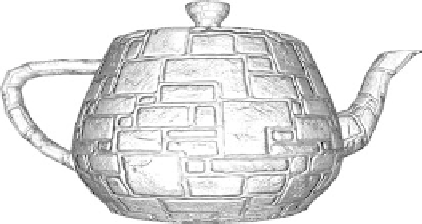Graphics Reference
In-Depth Information
of evaluating ambient, diffuse, and specular lighting on a per-fragment
basis. This example is a PVRShaman workspace that can be found in
Chapter_14/PVR_PerFragmentLighting
, as pictured in Figure 14-1.
Several of the examples in this chapter make use of PVRShaman, a shader
development integrated development environment (IDE) that is part
of the Imagination Technologies PowerVR SDK (downloadable from
Figure 14-1
Per-Fragment Lighting Example
Before we get into the details of the shaders used in the PVRShaman
workspace, we need to discuss the general approach that is used in the
example. The simplest way to do lighting per-fragment would be to
use the interpolated vertex normal in the fragment shader and then
move the lighting computations into the fragment shader. However, for
the diffuse term, this would really not yield much better results than
doing the lighting on a per-vertex basis. There would be the advantage
that the normal vector could be renormalized, which would remove
artifacts due to linear interpolation, but the overall quality would be
only minimally better. To really take advantage of the ability to do
computations on a per-fragment basis, we need to use a normal map
to store per-texel normals—a technique that can provide significantly
more detail.
A normal map is a 2D texture that stores a normal vector at each texel.
The red channel represents the
x
component, the green channel the
y
component, and the blue channel the
z
component. For a normal map
stored as
GL_RGB8
with
GL_UNSIGNED_BYTE
data, the values will all be
in the range [0, 1]. To represent a normal, these values need to be scaled
and biased in the shader to remap to [−1, 1]. The following block of


